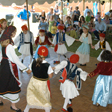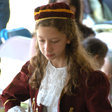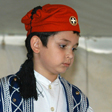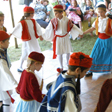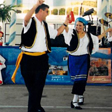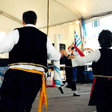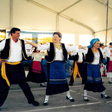Other Shreveport Articles
Cultural Preservation: Keeping the Flame Burning for Future Generations
Seasons and Cycles — Festivals and Rituals Mark Life's Rhythms
Of Hand and Heart: Handwork Connects Family and Community

Shreveport's Greek Community: Cultural Treasure Spanning Generations and an Ocean
By Laura Marcus Green
Dancing to a Cultural Beat: Georgia Booras
Among the cultural traditions Sophia passed on to her daughter Georgia is her love of dancing. Traditional dance has long been a staple at Greek weddings, baptisms, and any other festive occasions. In the Orthodox faith, people observe strict fasting during the 40 days of Great Lent and Holy Week, leading up to Pascha, or Easter. Georgia says that the Resurrection or Easter becomes a great celebration, a time for dancing. From her childhood in Shreveport, Georgia remembers:
Greek dance was just something you learned within your family. Whether it was a wedding or a baptism or any kind of family celebration or party, Greek dancing was just always part of it. My mother likes to dance and I think I probably learned from her, originally. And then as I got a little older, our church community started dancing for the Red River Revel, a local arts festival that started downtown in the '70s. The local women's organization of the church, which is really an ethnic organization, had a food booth there. And then we decided, well we're going to Greek dance down there. That's how our Greek dancing group started. We would perform to show them our dances.
Today, Georgia leads the adult dance group—the Hellenic Dancers of St. George—and has taught several generations of young people to Greek dance.
Georgia remembers performing in public for the first time at the Red River Revel when she was around 14 years old. Her aunt, Katina Booras, was the instructor for the youth dance group at that time. Structured lessons, choreographed dances to particular songs, and costumes took this informal tradition out of its regular context into the mainstream community. Although she found it nerve-wracking at first, Georgia ultimately enjoyed performing and felt proud to share her culture with a new audience. Reflecting on that experience, she recalls,
To us, it's nothing special to get up and Greek dance. But the crowds just loved it. And then that made us feel good. The first year the kids performed, they just couldn't believe that the crowds were that excited and that enthused, and that just made them more excited. They loved it.
When teaching Greek dancing, Georgia often starts her students off with a dance step she considers the most popular, called the Kalamatiano [ka-la-mot-ya-NO], which originated in Greece's Kalamata region, known for its olives. With a 7/8 beat the Kalamationos is a lively dance. Georgia points out that there are faster dances and slower ones. The Kalamatiano is composed of 12 steps, which are repeated. According to Georgia, mastering this basic dance allows people to dance to around 85% of any Greek music they might encounter. Dances like the Kalamatiano are done in an open circle, with the dancers holding hands with the people on either side of them. Most circle dances move in a counterclockwise direction. Some dances are done in a straight line. All of the dancers do the same step in rhythm in the same direction, so the circle or line moves in unison. Georgia points out that this can be helpful if someone doesn't know the steps very well. As long as you can keep the rhythm and move along with the others, you can learn as you go.
Georgia likes Greek dancing, as it is a very welcoming tradition. People of any age can dance, a partner is not required, and you don't have to know the exact steps. The open circle and line formats make it easy for people to join the dancing at any time, which is encouraged. Dancing in a group adds to the fun. Sometimes additional circles or lines form, until the floor is covered with groups. While these informal qualities apply to dancing at parties and more casual occasions, performers work hard to be precise and dance in step with one another. In either case, Georgia reports that Greek dancing is great exercise!
A leader keeps the rhythm for the group, but can also do variations of the steps. There is etiquette relating to the leader. A leader may ask another dancer to come lead but otherwise dancers never join the circle in front of the leader. The songs are generally long enough for several people to take turns leading the group.
When asked what makes for good Greek dancing, Georgia says that she teaches her students, "To have fun, first of all. You can always tell when people are having fun when they're dancing because they're lighter on their feet and they kind of glide. They're not plopping with their feet, they're moving real smoothly. You can just tell by the expression on their face that it's fun."
Shreveport's Greek community is diverse; people emigrated from different areas of the country. During her youth Georgia learned dances simply as Greek, although she remembers her mother and others who grew up in Greece saying at parties, "Oh, that dance was from my village." From her experience, Georgia believes that most of the dances originated in certain areas of Greece, but that over time they have moved around the country. Dancers might add their own variations to a dance from a particular area, which would explain why people from a certain region know a given dance better than others or do it differently. This is especially true in the United States, where people from different parts of the home country have formed Greek communities.
During her youth, Georgia remembers attending summer conferences of AHEPA and the Daughters of Penelope. A highlight of these gatherings was meeting other Greek Americans and the big Greek night parties, which inevitably featured live bands and dancing. The conventions were a great source of new music, as the bands often sold their recordings.
Growing up in Shreveport, Georgia remembers that occasionally, people hired out-of-town bands to play at weddings. Then as now, there were no Greek bands in the area. Typically, a Greek band is composed of bouzouki, mandolin, drums, a singer(s) and sometimes a clarinet. The bouzouki is a stringed instrument of Greek origin in the lute family. The body is flat on the front and rounded on the back, and the instrument has either three or four sets of paired strings that make the bouzouki emblematic of Greek traditional music. The music might be instrumental, but most often it features vocals. Georgia recalls most households having treasured record collections of Greek music. "People would just throw on a record at joyous times." Then the dancing began. These days, she delights in finding some of her favorite old albums available for download from the web. Recorded or live music remains a feature of festive occasions, including weddings, baptisms, and name days.
Georgia comes by her love of music naturally on both sides of her family. Her father, the late George Booras, once directed the St. George choir. A trained musician, he sang in the Scottish Rite, the Shreveport Choral Society, and at weddings. Georgia was too young to sing in the choir when her father was director. As she came of age, the women in the choir encouraged her to join. She has always loved to sing and finds the hymns of the church especially beautiful. When she was in her mid-twenties, she joined the choir and has been a member ever since.
Currently, the adult group under Georgia's direction is composed of many of the same people she danced with thirty years ago, including some of her first cousins. Over the years, the Hellenic Dancers of St. George and the youth group—the Greek Feet—have continued to perform public events like the Red River Revel and St. George's Greek Festival. The groups are also called upon to perform on other occasions in the community. The youth dancers are in high demand because they are so cute, Georgia observes. Georgia reports that across the United States, most Greek Orthodox churches have youth dance groups who compete in regional competitions in areas that have larger Greek communities, such as California, New York, and Florida. People also enjoy seeing the adults perform from time to time. Georgia says about her cohort, "They may have to dust off their dancing shoes, but you never forget the dances."


